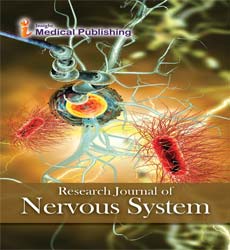A Note on Cervical Spine Issues and Neck Problems and its Symptoms
Giuseppe anza*
Department of Neuroscience, Newcastle University, Tyne, Uk
*Corresponding author: Giuseppe lanza, Department of Neuroscience, Newcastle University, Tyne, Uk, E-mail: Giuseppe lanza.edu.in
Received date: July 1, 2021; Accepted date: July 15, 2021; Published date: July 26, 2021
Citation: Lanza G (2021) A Note on cervical spine Issues and Neck Problems and its Symptoms. J Nerv Syst Vol.5 No.4: e007
Introduction
Cervical radiculopathy is the clinical portrayal of when a nerve root in the cervical spine becomes excited or harmed, bringing about an adjustment of neurological capacity. Neurological deficiencies, like deadness, changed reflexes, or shortcoming, may transmit anyplace from the neck into the shoulder, arm, hand, or fingers. A tingling sensation shivering as well as agony, which can go from pain-filled to stun like or consuming, may likewise transmit down into the arm and additionally hand. There are 8 sets of cervical nerve roots, numbered C1 through C8, in the cervical spine. These nerve roots branch from the spinal string and exit the two sides of the spinal trench through an intervertebral foramen (little hard opening between the nearby vertebrae). These cervical nerves then, at that point branch out further to supply muscles that empower working of the shoulders, arms, hands, and fingers. They likewise convey tangible filaments to the skin that give sensation. The most widely recognized reasons for cervical radiculopathy are the point at which a nerve root becomes kindled or harmed because of a close by bone prod or cervical herniated circle, for example, from spinal degeneration over the long run or a physical issue. Numerous other more uncommon reasons for cervical radiculopathy are conceivable, like disease or tumor. The specific system of nerve aggravation or harm isn't constantly perceived in cervical radiculopathy. Substance measures identified with aggravation are thought to most regularly make harm the nerve root that outcomes in radiculopathy, instead of a genuine mechanical impingement of the nerve root. The neck is essential for a long adaptable section, known as the spinal segment or spine, which stretches out through the greater part of the body. The cervical spine (neck area) comprises of seven bones (C1-C7 vertebrae), which are isolated from each other by intervertebral circles. These circles permit the spine to move unreservedly and go about as safeguards during action. Joined to the rear of each vertebral body is a curve of bone that shapes a constant empty longitudinal space, which runs the entire length of the back. This space, called the spinal trench, is the region through which the spinal rope and nerve groups pass. The spinal rope is washed in cerebrospinal liquid (CSF) and encompassed by three defensive layers called the meninges (dura, arachnoid, and pia mater). At each vertebral level, a couple of spinal nerves exit through little openings called foraminae (one to one side and one to one side). These nerves serve the muscles, skin and tissues of the body and in this way give sensation and development to all pieces of the body. The fragile spinal rope and nerves are additionally upheld by solid muscles and tendons that are connected to the vertebrae. Cervical stenosis happens when the spinal channel limits and packs the spinal string and is most habitually brought about by maturing. The plates in the spine that different and pad vertebrae may dry out and herniate. Subsequently, the space between the vertebrae recoils, and the circles lose their capacity to go about as safeguards. Simultaneously, the bones and tendons that make up the spine become less malleable and thicken. These progressions bring about a narrowing of the spinal waterway. Moreover, the degenerative changes related with cervical stenosis can influence the vertebrae by adding to the development of bone spikes that pack the nerve roots. Gentle stenosis can be dealt with minimalistically for expanded timeframes, as long as the manifestations are confined to neck torment. Extreme stenosis expects reference to a neurosurgeon.
Open Access Journals
- Aquaculture & Veterinary Science
- Chemistry & Chemical Sciences
- Clinical Sciences
- Engineering
- General Science
- Genetics & Molecular Biology
- Health Care & Nursing
- Immunology & Microbiology
- Materials Science
- Mathematics & Physics
- Medical Sciences
- Neurology & Psychiatry
- Oncology & Cancer Science
- Pharmaceutical Sciences
